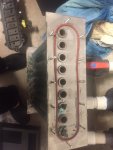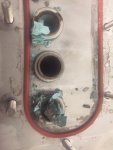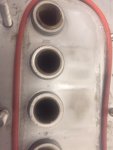UPDATE: Phosphate-Related Scale in Heat Exchanger of 1 Year Old Heater
So, per earlier posts, my heater works fine but produces tuquoise/white and black flakes that test when ground up to be a ratio of 10 parts po4 to 3.5 parts copper to 2.5 parts iron. I don't know if there's also zinc in there (plated zinc can be blue) but it doesn't fizz so if there's any calcium, its not much. My ch is 190.
Today I had a Raypak authorized heater pool tech with 40 years experience out to inspect the heat exchanger before putting up dome for winter (his family owns the pool const and service company. He is in my books highly competent.)
And we have stumped him

1. The scale shed is def coming from the heater, not the swg
2. The cupronickel tubes do not appear corroded, nor is there evidence of ridging
3. However, in two of the return side tubes, there was a buildup of something scale-like that was partially clogging the tube
4. The intake side tubes were clean
5. The unitherm governor had the same buildup, which may have been interfering with regulation. Its a cheap part so he replaced it for maintenance purposes.
6. The heater guts look otherwise brand new.
Here are pictures of the heat exchanger.
My pet theory is that my high po4 levels are enacting chemgeek's phosphate scale formula, causing excessive coating, but that for some reason its not "sticking" at least, uniformly, to the tubes and therefore they still transfer heat.
The takeaway is that I may need to consider po4 removal (ongoing) to preserve heater or alternately, plan annual heat exchanger maintenance, or possibly both.
PS...He also feels Raypak is off-base requiring a check valve with swg because "it can't possibly produce chlorine unless its under flow." Pretty much verbatim Joyful's comment

That said, he installed one with a flow meter so that should any warrantied failure occur, we've complied with the new installation instructions





 Me too. But don't they have to specify in the msds?
Me too. But don't they have to specify in the msds?




